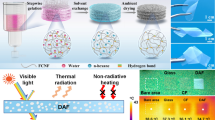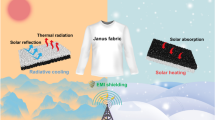Abstract
Transparent heat insulation materials (TIMs) exhibit great potential for different solar applications. Despite this fact, they are not used widely, since they are either very expensive (aerogel) or made from organic materials and, thus, are not resistant to higher temperatures. Xerogel, obtained from silica gel by drying at ambient pressure, is a promising material for the production of TIMs. This study investigates different treatments applied during the production of silica gel and their influence on its optical and structural properties. To this end, silica sol was gelled and the resulting silica gel was aged before it was either hydrothermally treated or fired. Subsequently, radiation transmission measurements from 400 to 2700 nm as well as porosity, specific surface area, and scanning electron microscopic/transmissions electron microscopic measurements were conducted. It was found that under certain conditions, the transmittance can be improved by firing as well as by hydrothermal treatment. Firing at 600 °C with 10-min dwell time and hydrothermal treatment at 120 °C with 5-h dwell time resulted in the silica gels with the highest transmittance of 63 up to 66 %. The porosity (24–76 %), the pore radii (3–26 nm), and the specific light absorption by embedded water and SiOH molecules could be adjusted over a wide range.
Graphical abstract



















Similar content being viewed by others
References
Stieglitz R, Heinzel V (2012) Thermische Solarenergie: Grundlagen, Technologie, Anwendung. Springer, Berlin, Heidelberg
Reiter C, Trinkl C, Zörner W (2011) Solarthermie 2000plus: Kunststoffe in solarthermischen Kollektoren- Anforderungsdefinition. Konzeptentwicklung und Machbarkeitsbewertung, Ingolstadt
Voss K (1997) Transparente Wärmedämmung: Stand der Technik. Sonnenenergie und Wärmetechnik 1:18–21
Fachverband Transparente Wärmedämmung e.V. (2000) Transparente Wärmedämmung: Eigenschaften und Funktionen, Gundelfingen
Klein G (2008) Energieeffizient bauen. Innovationen mit Kunststoff. Kunststoffe 12:80–84
Wei G, Liu Y, Zhang X et al (2011) Thermal conductivies study on silica aerogel and its composite insulation materials. Int J Heat Mass Transf 54:2355–2366
Steiner S (2014) Silica aerogel. http://www.aerogel.org/?p=3. Accessed 17 Jun 2014
Reichenauer G, Noisser T, Ebert HP, Weigang L (2009) Poröses SiO2 Xerogel mit charakteristischer Porengröße, dessen trocknungsstabile Vorstufen und dessen Anwendungen (DE10 2009 053782A1)
Pilz A (2012) Innovativ dämmen mit Aerogel. Applica 9:14–21
Lee JK, Gould GL (2007) Polydicyclopentadiene based aerogel—a new insulation material. J Sol-Gel Sci Technol 44:29–40
Hauer A (2002) Beurteilung fester Adsorbentien in offenen Sorptionssystemen für energetische Anwendungen. Technische Universität Berlin, Berlin
Titulaer MK, den Exter MJ, Talsma H et al (1994) Control of the porous structure of silica gel by the preparation pH and drying. J Non-Cryst Solids 170:113–127
Christy AA (2011) Effect of hydrothermal treatment on adsorption properties of silica gel. Ind Eng Chem Res 50:5543–5549
Titulaer MK, Jansen J, Geus JW Fluid composition effects on silica gel aging. J Non-Cryst Solids 170:11–20
Schmitz JO (2000) Zum Einfluss der hydrothermalen Alterung auf die Sorptionseigenschaften von Trägergelen für die heterogene Katalyse. Dissertation, Gerhard Mercator Universität Duisburg
Tschritter H, Daßler B, Knölle G, Herbst A, Wiesner R (2006) Verfahren zur Herstellung von hochreinem Silicagel (DE102006022685A1)
Iler RK (1979) The chemistry of silica. solubility, polymerization, colloid and surface properties and biochemistry. Wiley, Canada
Schießl C (2008) Thermische Analyse- Möglichkeiten zur Untersuchung von dentalen Kunststoffen. Dissertation, Universität Regensburg
Shi F, Wang L, Liu J et al (2007) Effect of heat treatment on silica aerogels prepared via ambient drying. J Mater Sci Technol 23(3):402–406
Davis PJ, Deshpande R, Smith DM et al (1994) Pore structure evolution in silica gel during aging/drying. IV. Varying pore fluid pH. J Non-Cryst Solids 167(3):295–306. doi:10.1016/0022-3093(94)90252-6
Brinker CJ, Mukherjee SP (1981) Conversion of monolithic gels to glasses in a multicomponent silicate glass system. J Mater Sci 16:1980–1988
Fournier RO, Rowe JJ (1977) The solubility of amorphous silica in water at high temperatures and high pressures. Am Miner 62:1052–1056
Brinker CJ, Scherer GW (1990) Sol–gel science. The physics and chemistry of sol–gel processing. Academic Press, New York
Pramanik A, Bhattacharjee K, Mitra MK et al (2013) A mechanistic study of the initial stage of the sintering of sol–gel derived silica nanoparticles. Int J Mod Eng Res 3(2):1066–1070
Brinker C, Roth E, Scherer G et al (1985) Structural evolution during the gel to glass conversion. J Non-Cryst Solids 71(1–3):171–185. doi:10.1016/0022-3093(85)90286-8
Kondo S, Tomoi K, Pak C (1979) The characterization of the hydroxyl surface of silica gel. Bull Chem Soc Jpn 52(7):2046–2050
Zarzycki J, Prassas M, Phalippou J (1982) Synthesis of glasses from gels: the problem of monolithic gels. J Mater Sci 17:3371–3379
Modest MF (2003) Radiative heat transfer, 2nd edn. Academic Press
Krol DM, van Lierop JG (1984) The densification of monolithic gels. J Non-Cryst Solids 63(1–2):131–144. doi:10.1016/0022-3093(84)90392-2
Scherer GW, Calas S, Sempéré R (1998) Densification kinetics and structural evolution during sintering of silica aerogel. J Non-Cryst Solids 240(1–3):118–130. doi:10.1016/S0022-3093(98)00696-6
Yoldas BE (1993) Technological significance of sol–gel process and process-induced variations in sol–gel materials and coatings. J Sol-Gel Sci Technol 1:65–77
Davis PJ, Brinker C, Smith DM (1992) Pore structure evolution in silica gel during aging/drying I. Temporal and thermal aging. J Non-Cryst Solids 142:189–196. doi:10.1016/S0022-3093(05)80025-0
Kondo S, Fujiwara F, Muroya M (1976) The effect of heat-treatment of silica gel at high temperature. J Colloid Interface Sci 55(2):421–430. doi:10.1016/0021-9797(76)90052-7
Ohmacht R, Matus Z (1984) Hydrothermal treatment of silica gel. Chromatographia 19:473–476
Leboda R, Mendyk E, Tertykh VA (1995) Effect of the hydrothermal treatment method in an autoclave on the silica gel porous structure. Mater Chem Phys 42(1):7–11. doi:10.1016/0254-0584(95)01561-2
Montgomery DC (2001) Design and analysis of experiments. Wiley, New York
Aines RD, Kirby SH, Rossman GR (1984) Hydrogen speciation in synthetic quartz. Phys Chem Miner 11:204–212
Acknowledgments
The authors are grateful to Dr. G. Schmidt from the Institute of Ceramic, Glass and Construction Materials for conducting scanning electron microscopy measurements as well as to Dr. V. Klemm from the Institute of Material Science, for the transmission electron microscopy measurements, both at TU Bergakademie Freiberg. Furthermore, Dr. R. Dittrich from the Institute Electronic and Sensor Materials is gratefully acknowledged for conducting the nitrogen adsorption and desorption measurements, also from TU Bergakademie Freiberg. The authors would like to gratefully acknowledge the financial support of the European Commission through the European Social Fund (ESF) and the Saxon State Ministry of Science and the Arts for the project ANWan (No. SAB 100109651).
Author information
Authors and Affiliations
Corresponding author
Rights and permissions
About this article
Cite this article
Klenert, F., Fruhstorfer, J., Aneziris, C.G. et al. Microstructure and transmittance of silica gels for application as transparent heat insulation materials. J Sol-Gel Sci Technol 75, 602–616 (2015). https://doi.org/10.1007/s10971-015-3731-3
Received:
Accepted:
Published:
Issue Date:
DOI: https://doi.org/10.1007/s10971-015-3731-3




